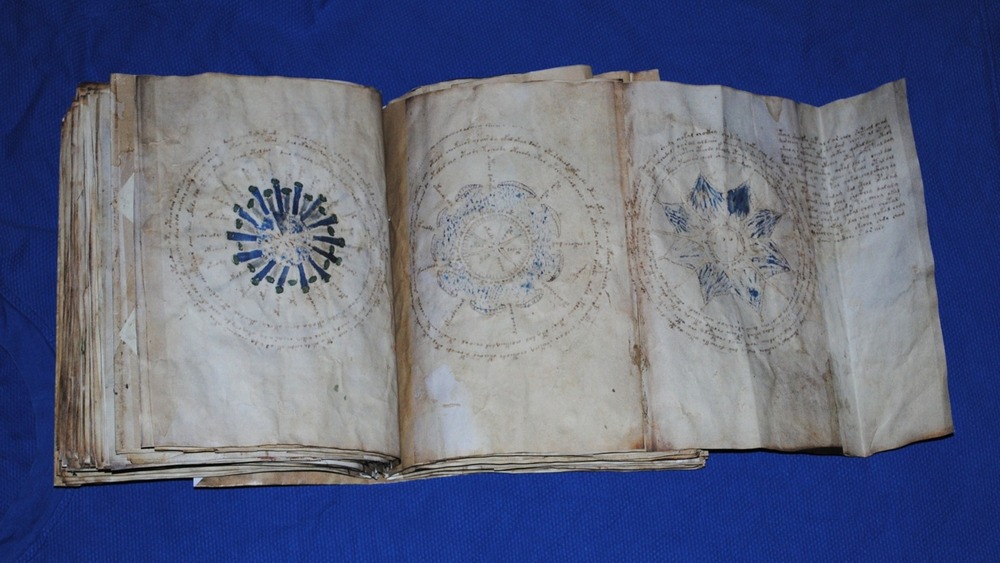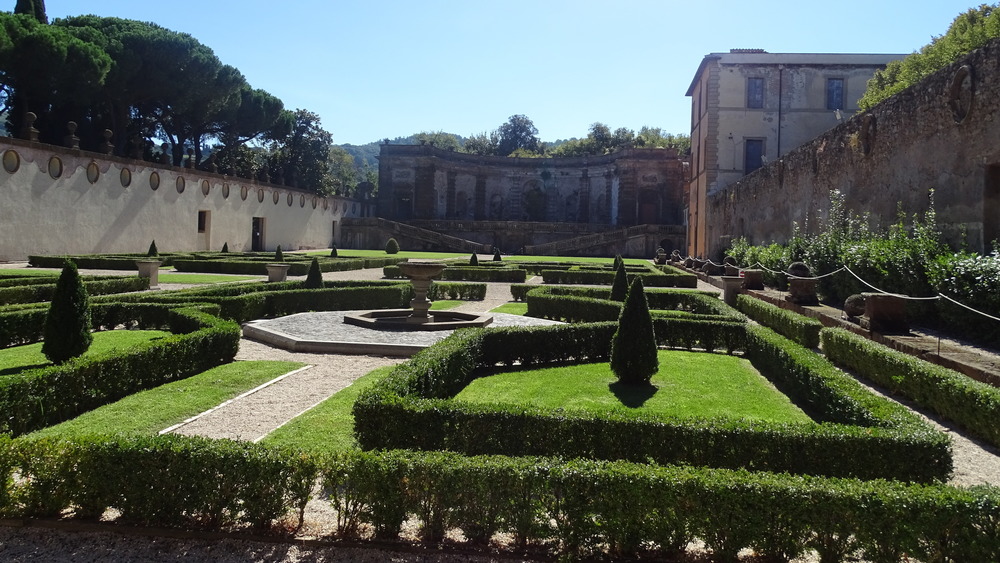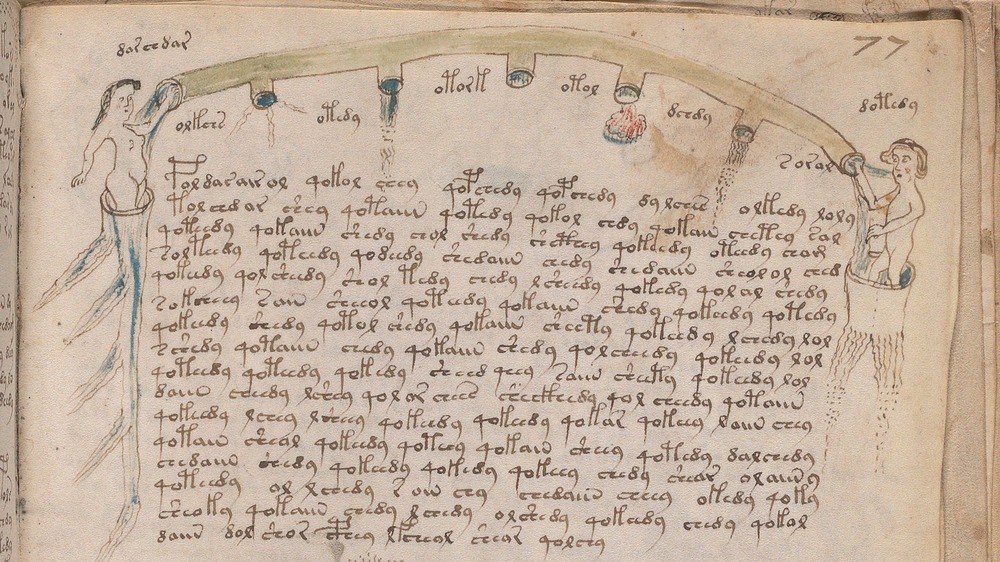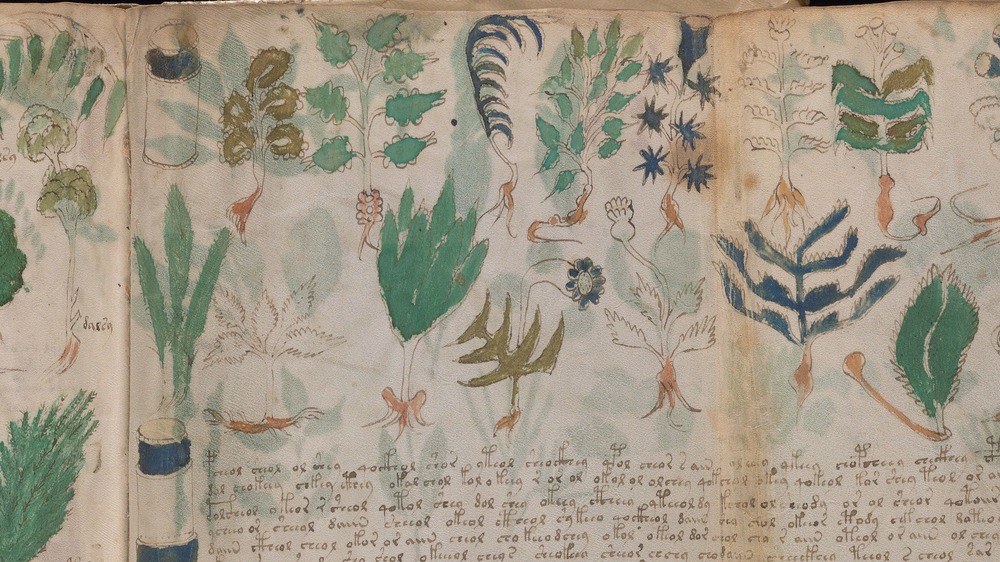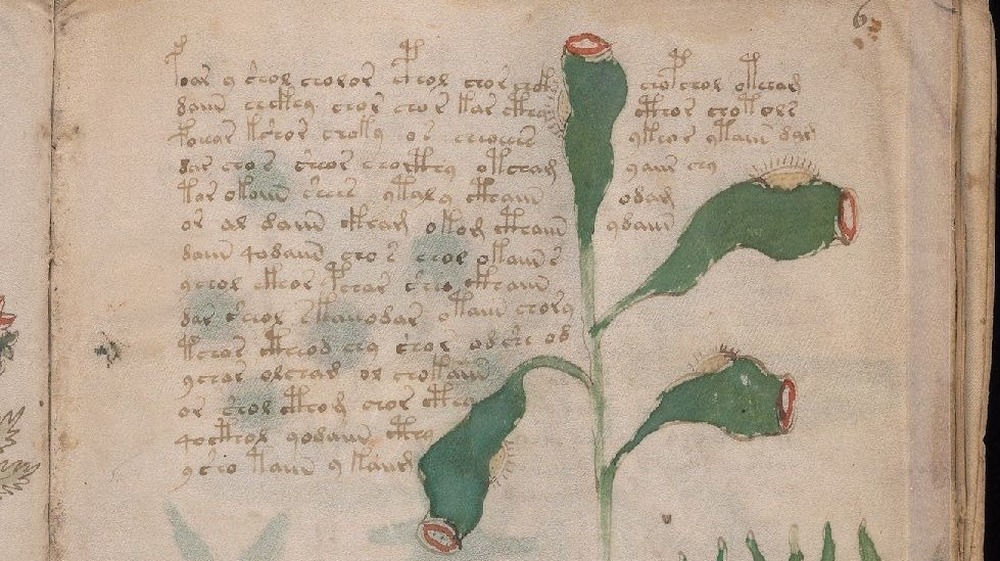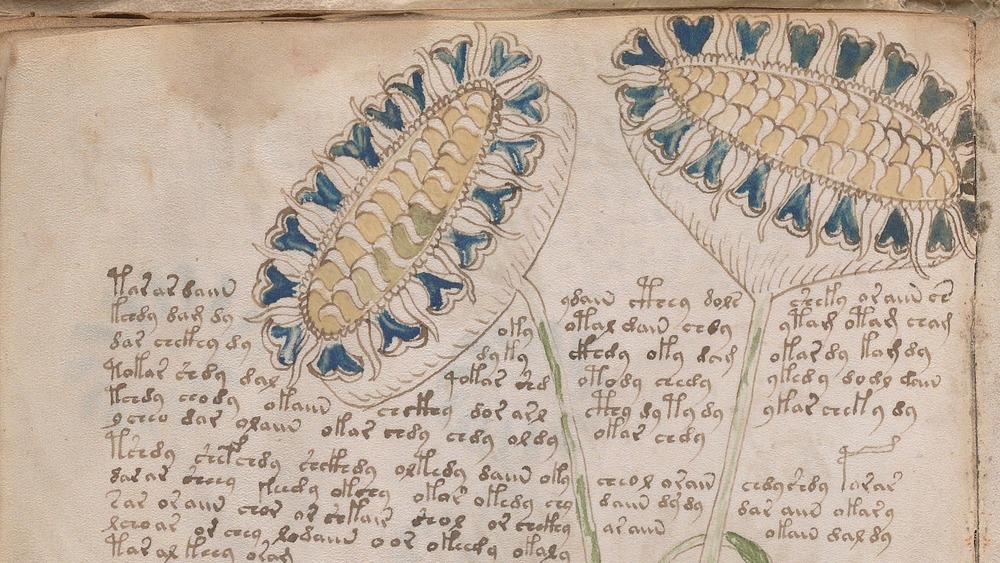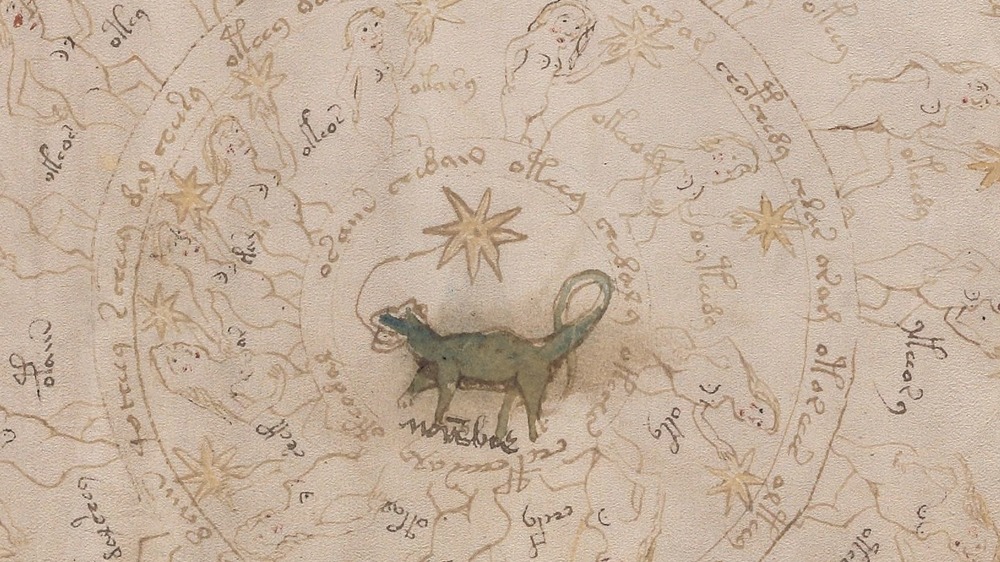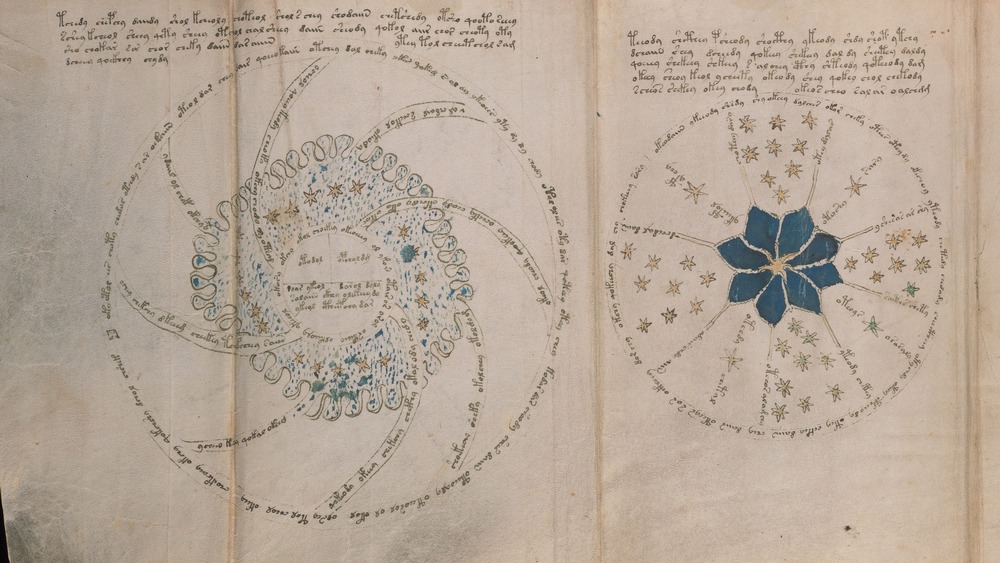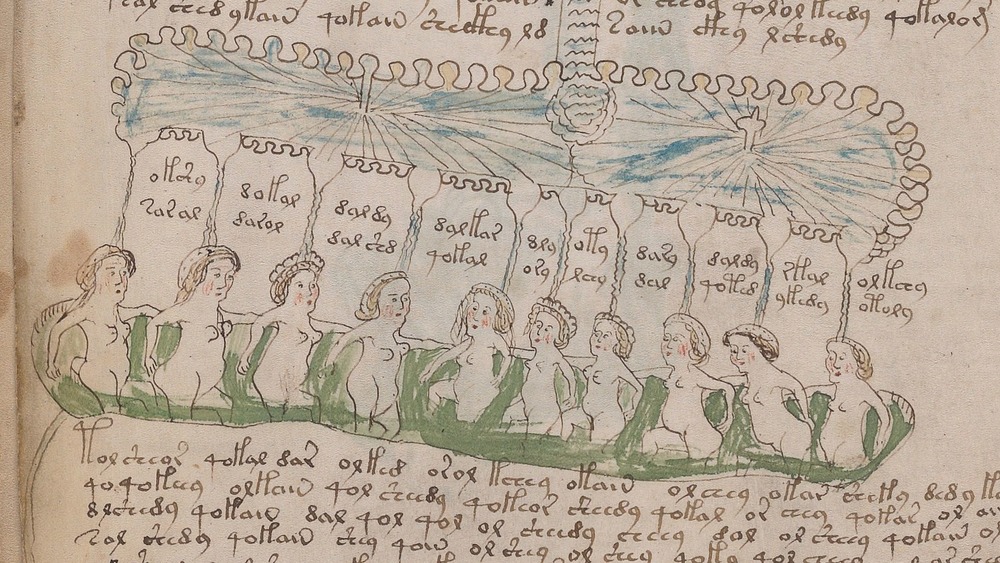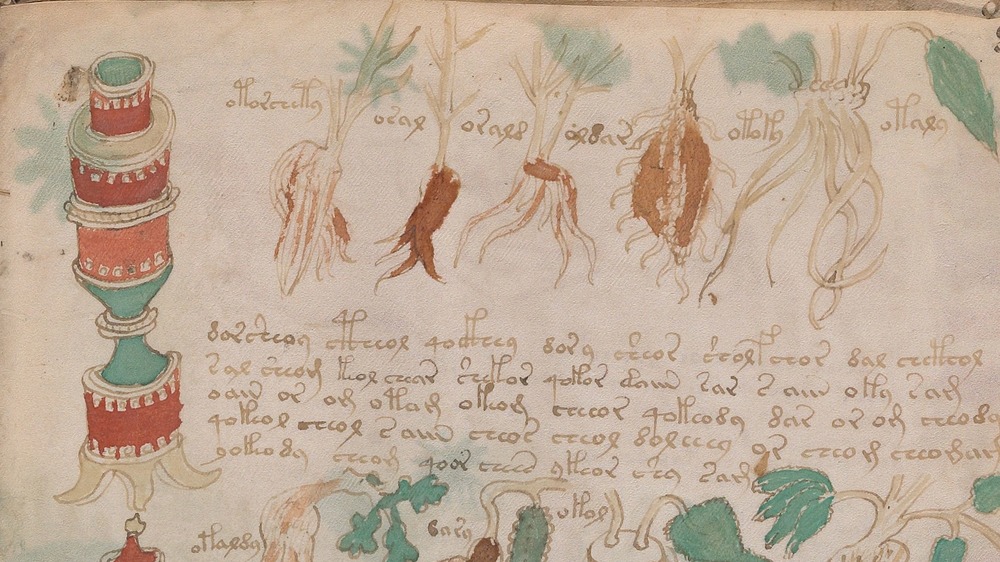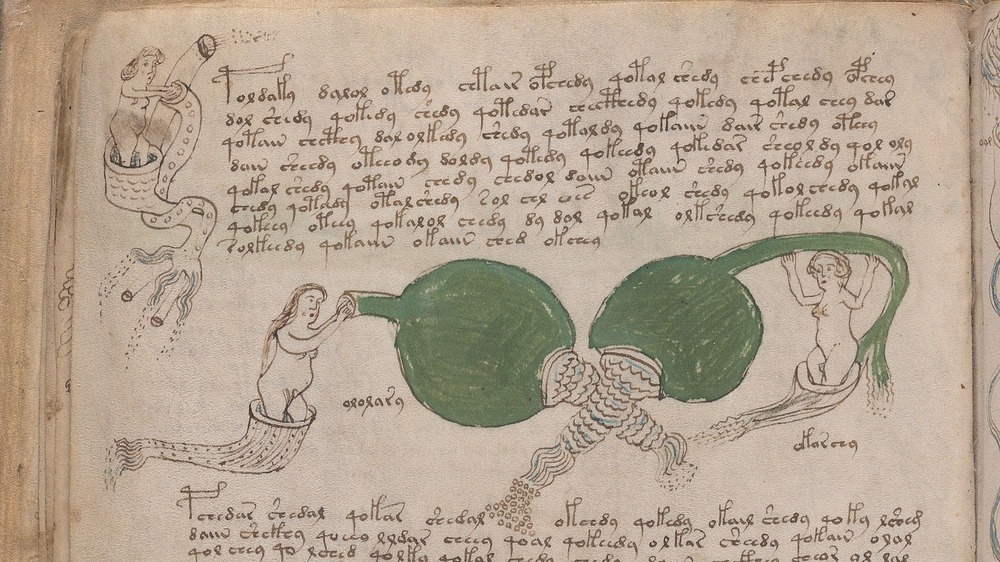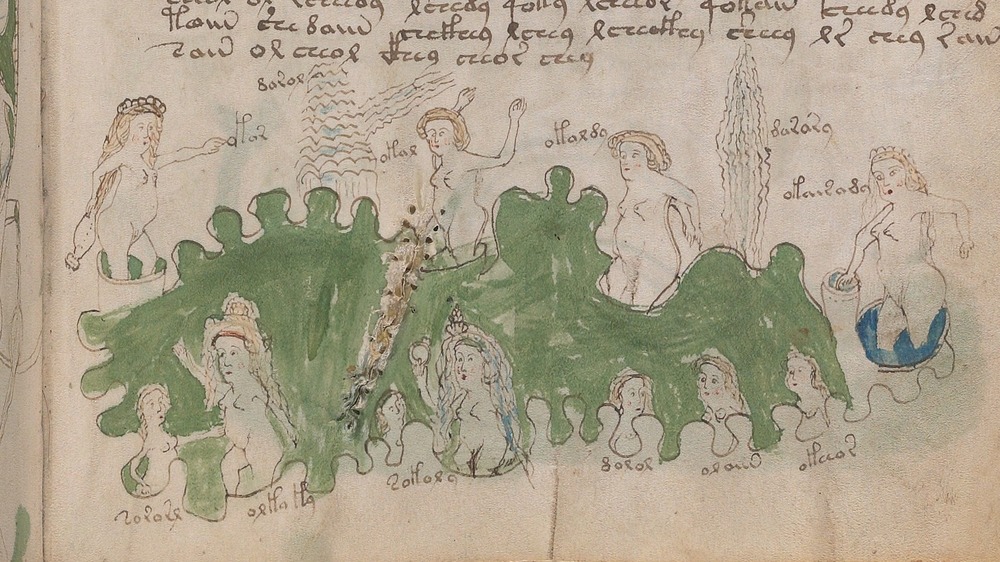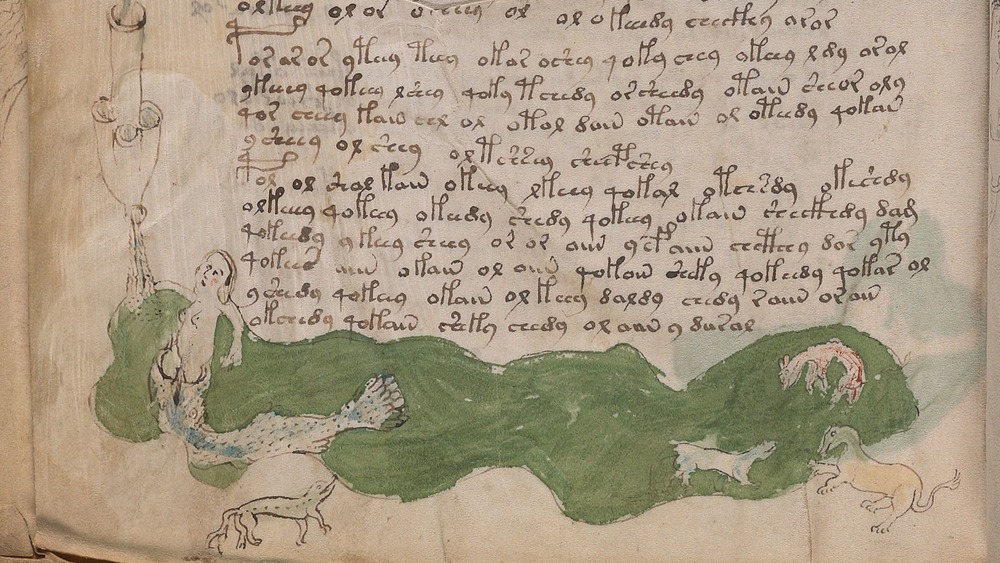The Crazy True Story Of The Mysterious Voynich Manuscript
One of the most baffling puzzles in history is stored at the Beinecke Library at Yale University. It is a codex that, while centuries old, doesn't have the beauty of the Book of Kells nor the size of the Codex Gigas, the so-called Devil's Bible. But what it lacks in beauty and bigness, it makes up for in bizarreness. It possesses a script that has confounded history's best cryptanalysts and has such perplexing imagery that some contend that only aliens could have crafted it. The most rudimentary search on Google Scholar reveals that countless academics have invested uncounted hours trying to solve it. Still, the codex defies all logic, reason, and any type of decoding nutcracker tasked upon it. Does it hold the secrets of the universe, or is it history's greatest hoax?
This is the famous Voynich Manuscript, which has been dubbed by many scholars, institutions, and publications, including Smithsonian Magazine, the "world's most mysterious manuscript." While its origin may go back centuries, its story really begins in 1912.
A mysterious manuscript emerges
Wilfrid M. Voynich, according to writers Gerry Kennedy and Rob Churchill in their book The Voynich Manuscript, was a Polish nationalist who had been imprisoned for his activities against the Russian Empire in the late 19th century. After his release, he turned to book collecting and became a prominent antiquarian book dealer. It was this capacity that brought him to Villa Mondragone near Rome in 1912. According to John H. Tiltman, writing a paper on the subject, the Jesuits had taken over the property some decades prior, and Voynich was nosing about for rare finds.
Voynich encountered something special when he found a manuscript buried in a chest among other codices. He wrote, as quoted by Kennedy and Churchill, "It was such an ugly duckling compared with the others that my interest was aroused at once."
The codex was unassuming. According to the Beinecke Library, it measures about 8.8 inches by 6.2 inches and is 240 pages in length. Research shows that the codex was once in the possession of Holy Roman Emperor Rudolf II, who bought it for 600 gold ducats because he believed that it had been written by scientist Roger Bacon. However, Bacon lived in the 12th century, and according to The New Yorker, radiocarbon-dating places the manuscript in the early 15th century. The codex disappeared in 1670, only to be discovered by Voynich nearly two and a half centuries later.
Voynichese 101
The Voynich Manuscript contains illustrations, charts, and lots of text. The one commonality of all of it, as analyzed by The Paris Review, is that it is utterly incomprehensible, both in text and images. The illustrations are either implausible or bizarre, filled with nonexistent plants and astrological charts. The text itself is made out in neat, orderly lines that look like writing, but no scholar has been able to crack the script, which is usually referred to as "Voynichese." According to The Verge, scholars have identified 25 to 30 individual characters in a loopy writing which seems to flow from left to right.
The reason why there is no definitive agreement on how many characters there are is provided by M.E. D'Imperio, author of The Voynich Manuscript: An Elegant Enigma, who explains that the characters sometimes blend too smoothly together to make out coherent symbols. However, because of the limited number of symbols, it seems that Voynichese is more likely to be an alphabet than a hieroglyphic script. As The Paris Review points out, the script seems to have the flow and structure of a real language, as if ideas were being conveyed. In other words, the characters and sentences don't appear to be randomized or mere gibberish.
Four parts, all weirdness
People who have studied the Voynich Manuscript have usually divided the codex into four parts. The Paris Review notes that this is not based on any table of contents but on what analyzers suppose what the contents are: herbal, astrological, balneological (having to do with bathing), and pharmacological. Other researchers, as described by National Geographic, divide the book into six sections, adding in astronomical and recipe sections and substituting the bathing section for biology.
Voynich himself, either looking to scare up buyers for his rare manuscript or diving into the mystery himself, said to The New York Times, "I will prove to the world that the black magic of the Middle Ages consisted in discoveries far in advance of twentieth century science." However, Voynich was never able to sell it. According to the Beinecke Library, the manuscript was given to Yale University by H.P. Kraus, who had bought it from Voynich's widow, in 1969. Kraus, like Voynich, was unable to sell it. This is just as well, since the manuscript has become available to all to puzzle over its strange contents.
Extinct plants?
The herbology section, the longest section which takes up half the book, according to The New Yorker, is what one might expect from a medieval text. There are somewhat amateurish, doodle-like illustrations of plants as one might find in a compendium. However, the plants seem to have no correlation to known plants. If you look at the digitized version at Yale University, you see things that are vaguely familiar, such as flowers, roots, leaves, and a blue thing that looks like a showerhead. All of this is accompanied by the attractive, flowing, and undeciphered text, giving it an authoritative feel.
According to M.E. D'Imperio, author of The Voynich Manuscript: An Elegant Enigma, many have tried to figure out the meaning of the codex through this section, hoping to link some real-world plant to the text. To D'Imperio, the plants appear to be amalgamations, with the flowers of one plant and the roots of others, or simply entirely alien. This has led to some debate, with some botanists identifying a plant and others disagreeing with that identification.
Is the Voynich Manuscript from Mexico?
One example of how the herbal section was used to try to gain some understanding of the Voynich Manuscript was by researcher Hugh O'Neill. In his 1944 study, published in Speculum, O'Neill asserted that one drawing was clearly a sunflower and another Capsicum (peppers). O'Neill argued that since both sunflowers and peppers were New World plants, the Voynich Manuscript must have an origin in the Western Hemisphere.
Jules Janick and Arthur Tucker argue in their 2018 book Unravelling the Voynich Codex that the manuscript must have originated from Mesoamerica and would have been created by a Mesoamerican, probably Aztec. They also identified a number of what they purport to be American fauna in the document. Purdue University states that Janick and Tucker believe that the manuscript, once translated, would yield valuable information regarding Native American culture before European conquest. As for Voynichese, they contend that it is a synthetic language based on Mesoamerican languages. They were still unable to translate it, however. This theory seems to have gained little traction because presumably one person's Capsicum is another person's "huh?"
Read your fortune, Voynich-style
The Voynich Manuscript gets stranger after the herbal section, when you enter its astrological section. As The Paris Review describes, this section contains what appear to be cosmological drawings and diagrams. The manuscript contains a number of fold-out astrological charts. As The New Yorker points out, these diagrams seem to be similar to zodiac-based charts found in medieval texts. However, these charts do not correspond to any known calendar.
More puzzling still, as reported by Smithsonian Magazine, is the presence of nude women (referred to as "nymphs") and indeterminate animals. As the digitized version from the Beinecke Library shows, there are charts with women in a circle holding stars with various figures in the center vaguely resembling goats, lizards, and other people — but it's in the eye of the beholder. All of these drawings are accompanied by inexplicable Voynichese. The imagery is so perplexing that NASA even posted a call for help to try to figure out if there is any scientific meaning behind the charts. Inexplicable astrological charts lead, naturally enough, to alien conspiracy theories.
Was the Voynich Manuscript made by aliens?
If the Voynich Manuscript is unexplainable, then surely it must be the diary of a marooned alien on a planet. One such hypothesis was reported by the Independent, which took a look at the outer fringe of Voynich theory and found a website called ancient-code.com proposing: "Because it contains a language that cannot be found anywhere else on the planet, and given the fact that the ancient manuscript depicts star charts that are unknown to us, the Voynich manuscript could have been created by a being not from Earth, who during the 1400s crash-landed on Earth and created the manuscript documenting life on Earth. Knowing that humans did not possess the necessary technology to help the alien visitor return to his planet, it is possible that the alien visitor decided to chronicle his remaining life on our planet inside the manuscript."
A variation of this theme was put forth by Jerome A. Kroth in his book Aliens and Man. He contends that one of the astrological doodlings in the codex looks like the spiral of the Milky Way galaxy. The author goes through a variety of hypotheses before offering, "...the reason it has eluded modern cryptography's search for a language to which it might be linked is precisely because the manuscript has no human linguistic counterpart, that is, a language unknown on this earth." While Kroth admits that the idea is "far flung," it seems that any hypothesis about the strange manuscript is as good as any other.
It gets weirder...
If the Voynich Manuscript had been driving down the Death Road of oddity, in the next section, it dives off the cliff. The third part of the codex, the balneological section (the science of bathing), contains drawing after drawing of naked women (the nymphs) in organic-type pods being doused with or soaking in fluids (usually green) from Salvador Dali-esque pipes. In some of the drawings, fanciful animals appear, and in another, a nymph seems to be a mermaid. Again, the quality of the drawing is rudimentary, and they are all surrounded by the neat Voynichese text, which one might expect explains the whole thing.
Smithsonian Magazine points out one image that appears to show two nymphs holding up a pair of ovaries. The balneological section is like what would happen if Tim Leary took a time machine and slipped Hieronymous Bosch (but with lesser artistic talent) LSD. M.E. D'Imperio notes in The Voynich Manuscript: An Elegant Enigma that this is the most mysterious part of the manuscript and is one of the most speculated-about.
The Voynich Manuscript's climax
That brings us to the last part of the manuscript, which is generally called the pharmacological, or pharmaceutical, section. This part returns to plant drawings, which are maybe more vegetable- than flower-like, but this time, it is aligned with objects that, according to The Paris Review, resemble hookahs, although one could make the case that they look like multi-tiered wedding cakes or burial urns. This is followed by pages of pure Voynichese, with divisions in the text marked by stars.
According to the Beinecke Library, this is the "recipe" part of the manuscript, though, admittedly, nobody really knows what it is saying. As a reminder of its weirdness, the last page has one more doodle of a nymph and an animal scribbled in the corner. This last section, in combination with the bathing section, have led people to speculate, as The Verge reports, that the Voynich Manuscript may be medical or alchemical in nature. One theory, reported by Ars Technica, claims that the Voynich Manuscript is a women's health manual, plagiarized from medieval Latin texts.
Even history's greatest codebreakers couldn't figure the Voynich manuscript out
There have been repeated attempts to decipher the Voynich Manuscript. As related by the BBC's HistoryExtra, some of the most gifted cryptanalysts of the 20th century set their minds to it, including Alan Turing, mathematicians, medievalists, and the Federal Bureau of Investigation. William Friedman, the head cryptanalyst of the U.S. Army's Signal Intelligence Service who cracked Japan's "Code Purple" during World War II, spent three decades trying to decipher it. According to the Folger Library, Friedman even used some of the earliest computers to try to break the code of Voynichese. He published his conclusion in an encoded anagram in a 1959 article concerning anagrams in the works of Geoffrey Chaucer. The solution remained sealed until his death, upon which his opinion was revealed: "The Voynich MS was an early attempt to construct an artificial or universal language of the a priori type. — Friedman."
Inevitably, there is a person or a group that claims to have deciphered the manuscript. Recent examples include a 2020 claim by a German Egyptologist published in The Art Newspaper, a 2019 claim published in The Guardian that the document was a therapeutic reference book for the Queen of Aragon, a 2018 claim published by National Geographic, and a 2017 claim published in the Times Literary Supplement based on the women's health manual theory. All of these solutions have fallen flat.
Is the Voynich Manuscript a hoax?
If all attempts to decipher the Voynich Manuscript have failed, it is natural to suppose it must be a hoax. One writer for the BBC concluded that the manuscript was an elaborate fraud perpetuated by Wilfrid Voynich himself. He, as an antiquarian, had a large stock of medieval-era vellum and fabricated the entire text. It would be helpful if the ink could be carbon-dated like the vellum. However, doing so is not easy, according to the University of Arizona, since ink often has low amounts of carbon or lacks it altogether. Gordon Rugg is one of the strongest proponents of the hoax theory. In his book Blind Spot, he argues that the fact that the best codebreakers in the world could not break the code is simply because there is no code.
However, if it is a hoax, then it is the most confounding hoax in history, and hot debate continues. As reported in Vice, Dr. Diego Amancio of the University of São Paulo's Institute of Mathematical and Computer Sciences ran large-scale statistical analyses of Voynichese and found that there seems to be an underlying pattern. "Our research has shown that the Voynich Manuscript presents a great deal of statistical patterns that are similar to those of natural languages," said Dr. Amancio, as quoted in Vice. If Voynich had spent all that time perpetuating the hoax, then he would have been a talented hoaxer, indeed.
So what is the Voynich Manuscript, really?
If the Voynich Manuscript isn't a hoax, then what is it? What is its secret? There are many theories, but none have had any degree of sustainability. It appears that the world's most mysterious manuscript is what you make of it. It possesses a mystique which leads one to believe that through it, you can learn the secrets of the universe — or maybe the presence of extraterrestrials. As pointed out by The New Yorker, "This single, original manuscript encourages us to sit with the concept of truth and to remember that there are ineluctable mysteries at the bottom of things whose meanings we will never know."
Because of modern technology, there is an ever-growing number of Voynich researchers. A high-resolution version of the manuscript has been digitized by the Beinecke Library, which has allowed a proliferation of groups on Reddit and other websites to speculate on this document which will likely remain an enigma. Ultimately, the Voynich Manuscript says more about humanity's need to find an answer than the actual answer itself.
